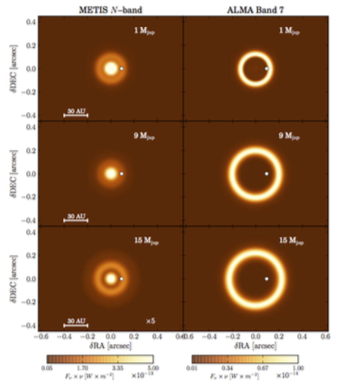Rationale
Astronomical observations in the thermal infrared wavelength regime (3-26 micron) provide a powerful tool to discover and characterise the most obscured sources in the universe. Thermal-IR instruments serve a broad range of astronomical disciplines from proto-planetary disks, the building blocks of planets, to active galactic nuclei, the surroundings of accreting supermassive black holes. The thermal-IR is also the wavelength of choice to characterise exoplanet atmospheric composition and motions, and perhaps even probe Earth-like exoplanet atmospheres. These critical science areas push instruments to their limits, demanding sensitivity, stability and contrast which ultimately rely on complete instrument characterisation and calibration.

Simulated images of disk-planet interaction models for the case of an embedded planet orbiting at 13 AU (white dot) around a solar-mass star. The disk is assumed to be at a distance of 150 parsecs (pc). The left and right columns correspond to METIS images at N-band and ALMA images at 850 μm, respectively. Top, middle and bottom rows show images obtained for planet masses of 1, 9 and 15 MJupiter, respectively. From Brandl et al. 2018.
Calibration in the thermal-IR will become even more important for the next generation of instruments and extremely large telescopes. Characterising earth-like exoplanets is one of the prime science cases of METIS, the NOVA-led first-light instrument for the European Extremely Large Telescope (2025), which will be the premier facility for these scientific efforts. On shorter time scales, the European Southern Observatory (ESO), together with the Breakthrough Initiative, are currently upgrading the VLT thermal-IR imaging instrument VISIR to search for an earth-like planet surrounding our nearest star system Proxima Centauri (the NEAR project). On somewhat longer timescales, MICHI, the proposed thermal-IR instrument for the TMT (expected to be on Hawaii) is currently under study. It will also require exquisite calibration precision to deliver the performance the scientific community requires.
Despite their scientific importance, all current instruments suffer from imperfect calibration and none reach the fundamental shot-noise limit, the so-called background limited performance. VLT/VISIR, for example, was just recently upgraded, but is currently still about a factor 2 less sensitive than it could be. In order to reach the ambitious scientific goals, however, the new suite of thermal-IR instruments for the next generation of telescopes will need to be able to reach the fundamental shot-noise limit. This implies in particular that systematic effects in the calibration need to be understood and removed.
This is no small feat since, in the thermal-IR, sources of astrophysical relevance have to stand out against the glaring background from the atmosphere and warm telescope optics at a rate of typically 1:106. With the more complex, five-mirror design of the ELT, this problem will be exacerbated compared to current instruments. At the same time, however, much more stable detectors are becoming available in the thermal-IR and computing power is no longer a limitation for exploring new observing and analysis techniques.

The design of the secondary mirror has a significant effect on the telescope pupil as seen in the thermal infrared. A comparison of telescopes / instruments is useful to find the optimal design for future instruments / telescopes.
The current state-of-the-art 8m class telescopes have hosted thermal-IR instruments and the various groups in the Americas, in Japan and in Europe have encountered similar problems, but so far solved them independently and differently. In this network , we bring together the experts in the field to compare techniques and approaches, with an aim to ensure we have found the optimal approach. With the upcoming 30m telescope era it is essential to optimise our techniques to ensure we reach the noise floor. This is perhaps especially important on the 30m’s due to their cost, more complicated designs, and challenging science requirements. Now is the time to exploit our 8m class knowledge for the good of the future 30m’s.